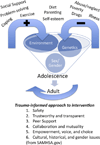Commentary on the special issue on the adolescent brain: Adolescence, trajectories, and the importance of prevention
- PMID: 27423540
- PMCID: PMC5268741
- DOI: 10.1016/j.neubiorev.2016.07.012
Commentary on the special issue on the adolescent brain: Adolescence, trajectories, and the importance of prevention
Abstract
Adolescence as highlighted in this special issue is a period of tremendous growth, synaptic exuberance, and plasticity, but also a period for the emergence of mental illness and addiction. This commentary aims to stimulate research on prevention science to reduce the impact of early life events that often manifest during adolescence. By promoting a better understanding of what creates a normal and abnormal trajectory, the reviews by van Duijvenvoorde et al., Kilford et al., Lichenstein et al., and Tottenham and Galvan in this special issue comprehensively describe how the adolescent brain develops under typical conditions and how this process can go awry in humans. Preclinical reviews also within this issue describe how adolescents have prolonged extinction periods to maximize learning about their environment (Baker et al.), whereas Schulz and Sisk focus on the importance of puberty and how it interacts with stress (Romeo). Caballero and Tseng then set the stage of describing the neural circuitry that is often central to these changes and psychopathology. Factors that affect the mis-wiring of the brain for illness, including prenatal exposure to anti-mitotic agents (Gomes et al.) and early life stress and inflammation (Schwarz and Brenhouse), are included as examples of how exposure to early adversity manifests. These reviews are synthesized and show how information from the maturational stages that precede or occur during adolescence is likely to hold the key towards optimizing development to produce an adolescent and adult that is resilient and well adapted to their environment.
Keywords: Adolescence; Adversity; Amygdala; Anxiety; Inflammation; Prefrontal cortex; Puberty; Salience; Stress.
Copyright © 2016 Elsevier Ltd. All rights reserved.
Figures
References
-
- Andersen SL, Teicher MH. Delayed effects of early stress on hippocampal development. Neuropsychopharmacology. 2004;29(11):1988–1993. - PubMed
-
- Andersen SL, Teicher MH. Stress, sensitive periods and maturational events in adolescent depression. Trends Neurosci. 2008;31(4):183–191. - PubMed
-
- Andersen SL. Trajectories of brain development: point of vulnerability or window of opportunity? Neurosci. Biobehav. Rev. 2003;27(1–2):3–18. - PubMed
MeSH terms
Grants and funding
LinkOut - more resources
Full Text Sources
Other Literature Sources
Medical


